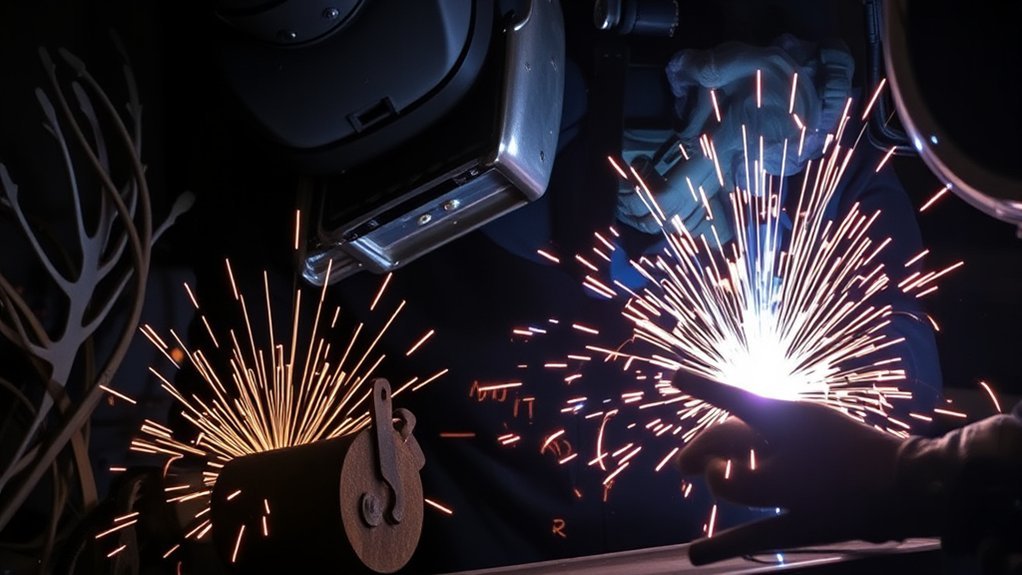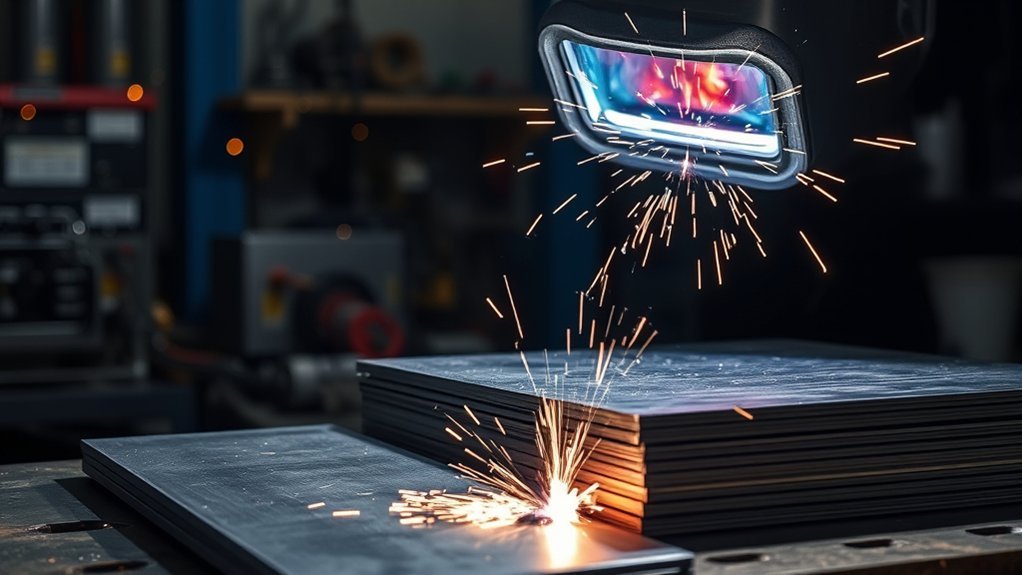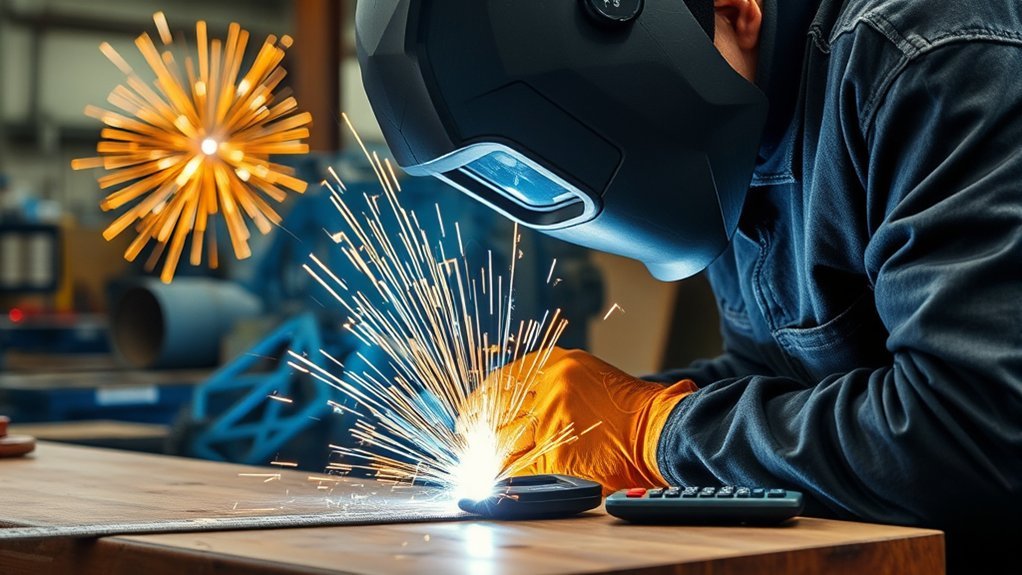In the U.S., welding costs per inch vary based on metal type and welding method. Generally, prices range from $0.50 to $4.00 per inch for typical shop and mobile work. For example, mild steel costs between $0.50 and $2.00, while aluminum can go from $1.25 to $4.00. Labor rates, influenced by technique, typically run from $50 to $125 per hour, according to recent national welding cost guides. Keep in mind that project complexity can also impact costs considerably. You’ll find more insights that can help you estimate your welding expenses effectively.
Factors Influencing Welding Costs per Inch

When you consider the factors influencing welding costs per inch, it’s important to recognize that various elements play a crucial role in determining the final price.
The type of metal greatly impacts costs, with mild steel, stainless steel, and aluminum each falling within different price ranges. Additionally, the welding techniques used, such as stick, MIG, or TIG, come with varying labor rates that directly affect overall expenses.
The choice of metal and welding technique significantly influences the overall costs of your welding project.
For instance, TIG welding incurs the highest labor costs. The complexity and thickness of the materials also contribute to increased labor rates, as specialized techniques may be necessary.
Finally, remember that labor and overhead typically constitute about 60% to 70% of your total project budget in welding, further influencing the cost per inch.
Cost Breakdown by Welding Method

Although each welding method has its own unique advantages and applications, the cost per inch can vary widely based on the technique employed. A cost comparison of common welding techniques reveals significant differences that can affect your budget.
| Welding Technique | Cost per Inch |
|---|---|
| Mild Steel | $0.50 – $2.00 |
| Stainless Steel | $1.00 – $3.50 |
| Aluminum | $1.25 – $4.00 |
| Stick Welding | $50 – $75/hour |
| MIG Welding | $65 – $90/hour |
| TIG Welding | $75 – $125/hour |
The complexity and thickness of materials can further influence these costs, often increasing hourly rates. Understanding these factors enables you to make informed decisions on welding projects.
Material Type and Its Impact on Pricing

Material type greatly influences welding costs, as each material presents unique challenges and requirements. Understanding these differences can help you avoid unexpected expenses:
Material selection is crucial for managing welding costs, as each type presents distinct challenges and requirements.
- Mild Steel: Costs range from $0.50 to $2.00 per inch, making it affordable for many projects.
- Stainless Steel: Prices vary from $1.00 to $3.50 per inch, requiring specialized techniques due to its corrosion resistance.
- Aluminum Welding: The most costly option, with prices from $1.25 to $4.00 per inch, demanding unique handling and advanced welding techniques.
- Filler Metals: Often contributing around 10% of total costs, these vary by material type and affect overall expenses.
Choosing the right material not only impacts cost but also requires specific welding techniques tailored to achieve strong joints.
Estimating Project Costs Effectively

How can you accurately estimate welding costs for your project?
Begin by considering the welding techniques and materials involved. Prices typically range from $0.50 to $4.00 per inch, depending on factors like metal type and complexity.
For instance, mild steel averages $0.50 to $2.00 per inch, while stainless steel varies from $1.00 to $3.50 per inch.
Labor costs, often comprising about 60% to 70% of total welding expenses, average between $50 to $125 per hour.
To enhance your cost estimation for welding cost per inch, gather multiple quotes from welders to understand market rates and review our step-by-step welding cost guide.
Additionally, account for project complexity and any extra materials, as these can greatly affect your overall budget.
Detailed job specifications will guarantee accurate and effective cost projections.
Tips for Saving on Welding Expenses

To reduce your welding expenses, start by simplifying your project designs, as complex shapes can drive up material and labor costs.
Opt for cost-effective materials like mild steel instead of pricier options, which can greatly lower the cost per inch of weld.
Additionally, handling preparatory tasks yourself can cut down on labor time and expenses, leading to more efficient project completion.
Simplify Project Designs
When you simplify project designs, you not only streamline the welding process but also markedly cut costs.
Enhancing design efficiency leads to substantial savings, as intricate shapes require more time and expertise.
Here are some strategies to contemplate:
- Combine parts to minimize joints and reduce welds.
- Plan ahead to avoid unexpected changes that complicate designs.
- Handle preparatory tasks like cleaning and assembling materials for greater labor efficiency.
- Opt for straightforward designs that retain structural integrity while reducing complexity.
Choose Cost-Effective Materials
Choosing cost-effective materials is vital for keeping welding expenses in check. Mild steel advantages include lower material costs, typically ranging from $0.50 to $2.00 per inch of weld, which can greatly reduce your overall budget.
In contrast, aluminum drawbacks include higher costs, often between $1.25 and $4.00 per inch. By opting for mild steel, you not only save on materials but also simplify your project designs, leading to reduced labor expenses.
It’s important to assess your project’s material needs carefully; by prioritizing cost-effective options, you can optimize your budget.
Handle Preparatory Tasks
Properly handling preparatory tasks can dramatically lower your welding expenses.
Implementing effective preparation techniques boosts labor efficiency and reduces overall costs.
Here are four essential tasks to take into account:
- Clean and Align Materials: Verify surfaces are free from contaminants to facilitate better weld quality.
- Simplify Designs: Minimize complexity to decrease material usage and streamline the welding process.
- Plan Ahead: Schedule jobs during off-peak times to negotiate better rates with welders.
- Provide Clear Specifications: Offer detailed project descriptions to receive accurate quotes and avoid unexpected costs.
Key Questions to Ask Your Welder
How can you guarantee you’re getting a fair deal on your welding project? Start by asking your welder about their specific hourly rate, which typically ranges from $50 to $125, depending on expertise and welding method.
Confirm if there are minimum charges for small projects, often equating to 1 to 2 labor hours (commonly around $100 or more). Inquire how they calculate costs per inch for various materials, noting that prices can vary from $0.50 to $4.00 per inch.
Inquire about minimum charges for small projects and how costs per inch are calculated, as prices can vary significantly.
Don’t forget to ask about additional costs for consumables, like filler metals and shielding gas, which may add around 10% to your total.
Finally, verify their welding certifications and experience with your specific welding needs to guarantee efficient project timelines and quality outcomes.
Frequently Asked Questions
What Additional Fees Should I Expect Beyond Welding Costs per Inch?
You should expect additional service fees for setup, labor, and equipment use, along with material costs for the metals being welded. These factors can considerably impact your overall welding expenses beyond just the per-inch rate.
How Can I Ensure Quality While Managing Costs?
To guarantee quality while managing costs, prioritize quality materials and skilled labor. Investing in experienced welders and durable materials minimizes future repairs, enhancing overall project longevity and efficiency without greatly inflating your budget.
Are There Minimum Charge Requirements for Small Projects?
Many welders impose a minimum project charge, commonly equal to 1 to 2 hours of labor (often around $100 or more), even for small jobs. This guarantees they cover overhead costs. Always ask upfront to avoid surprises and gauge overall project expenses effectively.
Does the Complexity of the Design Affect the Cost?
Yes, the design intricacies considerably influence the cost implications. Complex designs require more time and skill, increasing labor and material expenses. You should consider these factors when budgeting for your welding project.
Can I Negotiate the Price With My Welder?
Yes, you can negotiate the price with your welder. Use effective welding pricing strategies and contractor negotiation tips to discuss project specifics, emphasizing your budget. A clear communication can lead to a mutually beneficial agreement.
Conclusion
In summary, understanding the factors influencing welding costs per inch is essential for effective budgeting. By considering the welding method, material type, and potential savings strategies, you can make informed decisions that minimize expenses. Isn’t it worth taking the time to ask your welder key questions to guarantee you get the best value? With the right approach, you can achieve high-quality results without breaking the bank. Evaluate your project needs carefully to optimize your welding investment.


